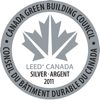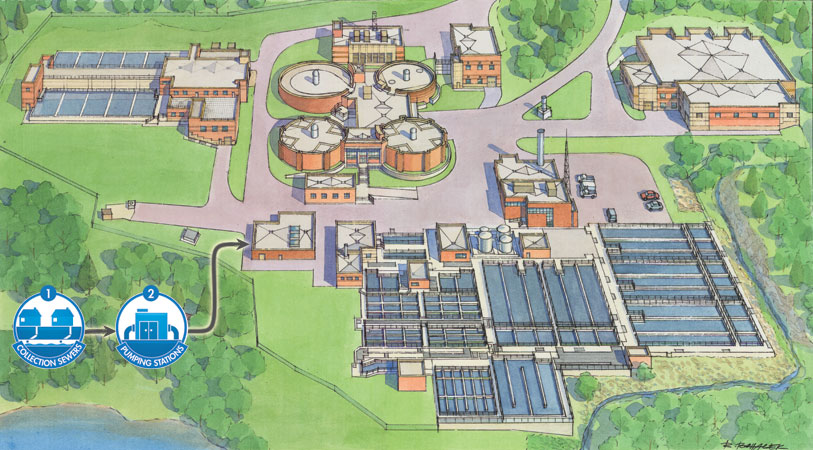From waste to water – a brief overview
A lot can happen in six hours!
That’s how long it takes for wastewater to flow through the Ravensview Wastewater Treatment Facility. During those short few hours, the waste undergoes an astounding chemical, physical, and biological transformation to produce three beneficial outputs:
- Natural resource quality water that’s safely returned to the St. Lawrence River
- Approximately 25 per cent of the site’s electricity needs
- Nutrients to help grow crops in local fields
Explore the Ravensview facility
Click a building on the map below to learn more about the facilities
Recommended: view this page on a desktop computer to get a clickable map of this facility.
| System | System description | Facility | Facility description |
|---|---|---|---|
| Conveyance system | The system for collecting wastewater and moving it to the water treatment plant | Collection sewers | Ravensview receives wastewater from the sewer collection system, servicing the Central and East areas of the City. Each house or business is connected to the collection system by a service lateral. The system carries the wastewater, largely by gravity, to the treatment plant. |
| Pumping stations | When gravity doesn’t provide enough drive to move wastewater along the system, pumping stations are used to help convey the wastewater to the treatment plant. | ||
| Primary treatment of wastewater | The removal of solid waste from the water | Bar screening | The first part of the on-site treatment process involves three large bar screens. Bar screening removes large trash items that could cause damage to plant equipment, such as sticks, plastics, rags, and other non-biodegradable materials. The materials (about 2.5 cubic metres per week) are then properly disposed of in landfill. |
| Grit aeration tank | After screening, the wastewater flows through two aerated tanks to facilitate the process of separating organic (biological) and inorganic (sand, gravel) waste. The organic material continues on to the settling process and the inorganics are collected and disposed of. | ||
| Settling tanks | Primary settling tanks provide an efficient process for removing solids that are heavy and sink to the bottom, as well as materials such as oil and greases that float to the surface. Settling tanks are designed to hold the wastewater for several hours. During this time, the heavy solids settle to the bottom to form thick slurry known as primary sludge, which is pumped to the solids process. The floating materials are skimmed and also pumped to the solids process. | ||
| Secondary treatment of wastewater | The removal of biodegradable contaminants, bacteria, and viruses from the water | Biological aerated filter | Wastewater flowing out of the settling tanks still contains some solids and dissolved materials. The biological aerated filter (BAF) system used at Ravensview is an innovative type of secondary treatment system. The BAF facility is a biological, active filter made of synthetic media, which removes organic material as the wastewater passes through it. |
| Disinfection | The final treatment process before water is returned to the river is disinfection. Sodium hypochlorite is added to the treated water to kill disease-causing bacteria and virus. The chlorinated water is held in tanks long enough for disinfection to occur before being returned to the river. | ||
| Solids processing | The removal of organic materials from the solids to produce biosolids and methane gas | Digestion | The main solids treatment process at Ravensview is anaerobic digestion, involving three primary digesters and one secondary digester. There are two modes of digester operation that can be used at Ravensview. Thermophilic mode operates at 55°C and provides a high level of digestion to produce a higher-quality biosolid and an increased amount of methane gas. Mesophilic is a standard mode operating at 35°C, which stabilizes the biosolids and produces methane gas. |
| Cogeneration | The methane gas produced by digestion is fed into an internal combustion engine running a generator. The generator produces 370 kW of electrical power, which serves approximately 25% of the plant’s power consumption requirements. The methane gas is also used in the boiler system for heating the building and digesters. | ||
| Solids dewatering | The removal of water from the solids to produce crop fertilizer | Solids dewatering | Following digestion, the secondary sludge still contains a significant amount of water. Two mechanical centrifuges (like huge blenders) are used to spin water from the sludge to produce dewatered biosolids. The sludge starts out at 2.5% solids. After dewatering, the solids content is increased to 28%. |
| Biosolids recycling | The biosolids are stored in bunkers. When crop growing season begins, the biosolids are applied to agricultural lands. They provide valuable nutrients that improve the condition of soil and yield better crops. To assure the safe reuse of this material, biosolids meet stringent regulatory requirements. | ||
| Process control | Laboratory | Ravensview has many complex processes that require continual monitoring and testing. The laboratory is used for testing the quality of the water as it passes through each process. The data is used to adjust 11 processes and to assure compliance with stringent regulatory requirements for the discharge of treated water and recycling of biosolids. |
- The original plant was built in 1957 as Kingston’s first sewage treatment plant using primary treatment to remove solids. It was upgraded in 1974 and again in 1993 to add capacity and chemically assist the primary treatment to achieve secondary results.
- Leadership in Energy and Environmental Design (LEED®) principles were applied across the entire Ravensview construction project. The administration building achieved LEED® Silver certification. Highlights include LEED® credits for bike storage, carpool parking, restoring natural habitat areas, open-space designation, supplying on-site renewable energy, and locally extracting and processing more than 12% of building materials.

Ravensview Wastewater
Treatment Facility
947 County Rd #2
Kingston, ON K7M 5J1
Treatment Facility
947 County Rd #2
Kingston, ON K7M 5J1
About 4.5 km east of Fort Henry,
on the south side of County Road #2

